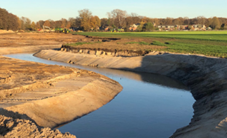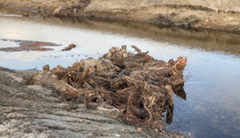Nature-based interventions offer ways to simultaneously achieve different goals related to engineering and ecological aspects of river management. The River Dinkel is one of the rivers where nature-based interventions have been implemented. These interventions include destoning river banks to allow natural riverbank dynamics, remeandering to lengthen the river and decrease the river slope so water is retained for longer durations, and installation of wood at the sides of the main channel to increase flow variability across the river. While such interventions can simultaneously satisfy several desirable objectives, it is still not clear how the river will respond to such soft measures. In addition, there are design constraints, such as a minimal influence on the water levels to prevent flooding, which introduce additional challenges in the implementation of nature-based interventions.


Figure 1 Examples of some nature-based interventions (left: remeandering; wood at the side of streams). Photos: Waterschap Vechtstromen (Dinkel agenda, 2022).
The aim of this project is to understand the impact of the implemented nature-based interventions on the flow of the River Dinkel and to explore the effect of additional potential river interventions. The intention is to use the existing 1D Sobek model that is available at the Waterboard but the Waterboard would also like some advice on which model is most suitable to study these interventions (they now use Sobek/D-Hydro and Tygron). The implementation of additional interventions will be done in consultation with experts from the Waterboard Vechtstromen. While the existing numerical models provides only hydrodynamic output and do not include morphodynamics, some modelling runs may include the bed evolution, either based on expert judgement, based on some simplified calculations, or hydro(morphological) modelling to investigate the long-term impact of the nature-based interventions. The analysis of the numerical simulations and the outcome of this project will inform the Waterboard about the type and scope of interventions that may or may not be acceptable. Finally, you can also compare how a simpler approach, such as calculations based on analysis of backwater curves, compares to the output of the 1D Sobek model.




